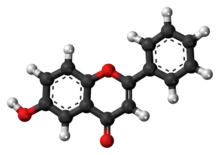6-Hydroxyflavone
 | |
 | |
| Names | |
|---|---|
| IUPAC name
6-Hydroxyflavone | |
| Systematic IUPAC name
6-Hydroxy-2-phenyl-4H-1-benzopyran-4-one | |
| Other names
6-Monohydroxyflavone; 6-Hydroxy-2-phenyl-4-benzopyrone | |
| Identifiers | |
3D model (JSmol) |
|
| ChEMBL | |
| ChemSpider | |
| ECHA InfoCard | 100.027.005 |
| EC Number |
|
| KEGG | |
PubChem CID |
|
| UNII | |
CompTox Dashboard (EPA) |
|
| |
| |
| Properties | |
| C15H10O3 | |
| Molar mass | 238.242 g·mol−1 |
| Melting point | 234 to 236 °C (453 to 457 °F; 507 to 509 K) |
Except where otherwise noted, data are given for materials in their standard state (at 25 °C [77 °F], 100 kPa).
Infobox references | |
6-Hydroxyflavone is a flavone, a type of chemical compound. It is one of the noncompetitive inhibitors of cytochrome P450 2C9. It is reported in Crocus and leaves of Barleria prionitis Linn. (a common Acanthaceae from India).[1] 6-Hydroxyflavone may have a potential as a therapeutic drug capable for the treatment of anxiety-like disorders.[2][3]
References
- M Daniel (2006). Medicinal Plants: Chemistry and Properties. Science Publishers. p. 78. ISBN 978-1-57808-395-4.
- Ren, Lihuan; Wang, Feng; Xu, Zhiwen; Chan, Wing Man; Zhao, Cunyou; Xue, Hong (2010), "GABAA receptor subtype selectivity underlying anxiolytic effect of 6-hydroxyflavone", Biochemical Pharmacology, 79 (9): 1337–1344, doi:10.1016/j.bcp.2009.12.024, PMID 20067772
- "6-HYDROXYFLAVONE | CAS:6665-83-4 | Huateng Pharma | Pharmaceutical chemical reagents, PEG derivatives". en.huatengsci.com. Retrieved 27 March 2020.
External links
- 6-hydroxy flavone on Plant Metabolic Network
This article is issued from Wikipedia. The text is licensed under Creative Commons - Attribution - Sharealike. Additional terms may apply for the media files.